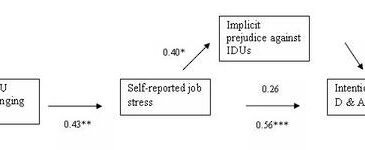Implicit prejudice, harboring negative associations toward particular social groups without conscious awareness, predicts a wide range of real-life behaviors, including discriminatory medical decisions (Green et al., 2007) and hiring practices (Ziegert & Hanges, 2005). Drug addicts are often the target of implicit prejudice by the general public. This week’s STASH reports on new research related to implicit prejudice toward injecting drug users (IDUs) among drug and alcohol (D&A) nurses (von Hippel et al., 2008).
Participants
• Participants were 44 D & A nurses in the Sydney, Australia metropolitan area recruited from D&A treatment facilities, needle and syringe exchange programs, and primary-care facilities that cater to IDUs.
Materials and Procedure
• Implicit prejudice toward IDUs was measured with the Implicit Associations Test, a computerized procedure that uses reaction times to measure how strongly people associate certain categories. Here, researchers measured how strongly participants associated the concept “injection drug user” with positive or negative personality attributes (e.g., “wonderful” versus “awful”). Each participant received a d score based on responses to this task. Positive d scores indicate stronger associations between IDUs and negative attributes; negative d scores indicate stronger associations between IDUs and positive attributes.
• Participants also completed a self-report measure of prejudice toward IDUs that directly asked 9 questions, such as “I avoid injecting drug users whenever possible” and “Injecting drug use is immoral” on a 5-point scale anchored by strongly disagree and strongly agree. The possible range was therefore 1 (indicating a low level of reported prejudice) to 45 (indicating a high level of reported prejudice). The mean score for this sample was 2.16 (SD = 0.60).
• Job stress was measured with 2 items (e.g., “Working with injecting drug users is really a strain for me”). Answers were provided on a 6-point scale ranging from never to every day.
• Intentions to change jobs was measured with one item (“During the next year, I will probably look for a new job in another area of nursing”). Responses were provided on a 5-point scale ranging from strongly disagree to strongly agree (mean score = 2.45; SD = 1.23).
• Participants also completed a 12-item measure of the extent to which their IDU clients exhibited a variety of challenging behaviors (e.g., verbal abuse, stealing) during treatment. Answers were provided on a 4-point scale, from never to often.
Results
• The average implicit prejudice score across all participants was d = 0.26 (SD = 0.26), which is significantly greater than zero (t(42) = 4.16, p < 0.001).
• As Figure 1 shows, nurses who reported that their IDU clients engaged in more challenging behaviors reported experiencing more job stress (β = 0.43, p < 0.01). More job stress, in turn, was associated with a stronger intention to quit D & A nursing (β = 0.56, p < 0.001). However, the relation between job stress and intention to quit D & A nursing was mediated by implicit prejudice toward IDUs (indirect effect = 0.175, 95% CI = 0.53-0.49). Greater implicit prejudice against IDUs appears to be the process through which job stress influences the intention to quit D & A nursing.
Figure. The mediated effect of stress on intention to change jobs among D & A nurses. Path coefficients represent standardized regression weights. The coefficient below the path between job stress and intention to quit D & A nursing represents the direct effect with no mediators in the model; the coefficient above the path represents the direct effect when the mediators are included in the model. Please note that for ease of presentation we have not represented two additional variables included in the original model. Analyses revealed that removing these variables from the model does not substantially change the results. * p < 0.05, ** p < 0.01, *** p < 0.001. Click image to enlarge.
Limitations
• Some have questioned the interpretation of implicit prejudice d scores, suggesting that there is no true zero point reflecting a cut-off between prejudiced and non-prejudiced responding (Blanton & Jaccard, 2006).
• The authors did not measure actual job turnover, but rather the stated intention to leave D & A nursing. Consequently, this research does not inform us about actual job changes.
• It is possible that the pattern of results varied as a function of study site (i.e., needle exchange programs versus primary-care facilities); this analysis was not included in the report.
Conclusions
The size of the average d score in this study indicates that, on average, the sample of nurses held a slightly strong association between IDUs and negative personality attributes. The authors speculate that D & A staff might believe (and report) on a conscious level that IDUs are worthy of care and sympathy, and yet still harbor negative associations about this group on an unconscious, or implicit, level. Challenging behaviors on the part of IDU clients and resulting job stress appears to increase implicit prejudice toward IDUs, which then increases the intention to quit D & A nursing. Identifying a process through which nurses decide to quit D & A nursing might be helpful to prevent staff burnout and turnover, which are prevalent problems in this subfield of nursing care.
What do you think? Please use the comment link below to provide feedback on this article.
References
Blanton, H. & Jaccard, J. (2006). Arbitrary metrics in psychology. American Psychologist, 61, 27-41.





